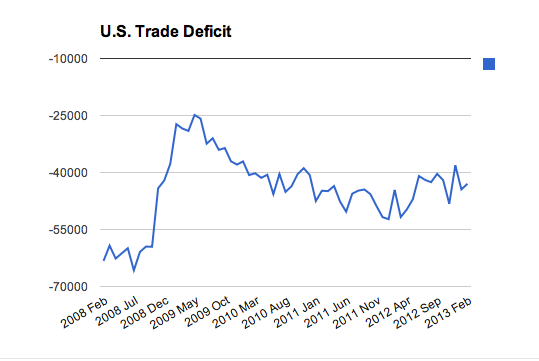The U.S. trade gap narrowed in February as oil imports fell to their lowest level since March 1996 while exports increased slightly, the Commerce Department announced on Friday. The lower trade came out at the same time as a discouraging jobs report and economists dismissed the idea that it would boost the economy.
Economists played down the narrowed trade gap for February as a sign of economic recovery. “This was in line with expectations,” said Dan Baker, economist and co-director of the Center for Economic and Policy Research. “Often times you see a big fall one month and then a recovery in the next month, but that is just an issue of timing.”
The revised trade deficit for January narrowed from $44.5 billion to $43.00 billion. Economists had estimated that the trade gap would widen slightly to $44.6 billion in February but instead it declined 3.4 percent.
“Imports of manufactured goods were set to rise so analysts predicted an expansion of the trade deficit based on that,” said Noah Smith, a finance professor at Stony Brook University. “They didn’t predict that oil moves very quickly and we imported so much less oil that our trade deficit actually shrank.” Smith believes the U.S. imported less oil because the economic growth is slowing down and so is consumer demand.
The U.S. imported less 56 million barrels of crude, importing 205 million barrels of crude in February, the lowest level in 17 years. Oil import prices rose almost $2 a barrel, to $95.96 in February. The oil products deficit narrowed to $21.2 billion in February, a 12.8 percent difference from January. Overall imports like consumer goods, capital goods and higher import of autos were at $229.9 billion in February, the same as in January. The trade gap with China narrowed to $23.4 million, its lowest level since March 2012, and exports to the European Union declined by 0.9 percent. U.S. exports rose slightly to $186.0 billion, a 0.8 percent difference from January. But industrial products like farm equipment and civilian aircraft declined, offsetting strong exports in autos and energy, as the U.S. has been producing more oil and natural gas.
Economists expect the trade deficit to narrow over time. As the U.S. economy is slowly recovering and the U.S. dollar remains at his current value, energy exports and the export of other products will rise. Europe is also expected to show signs of recovery and to increase imports of U.S. goods. “I think over the next few years we will see the deficit narrowing,” said Smith. “But from month to month it is hard to make that prediction.”
